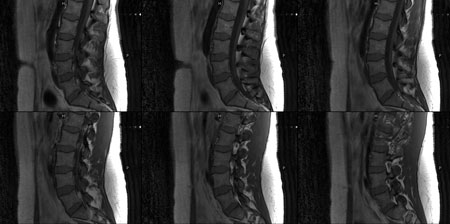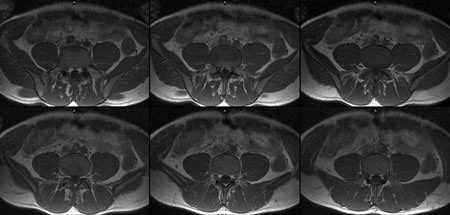
University home | Studying | Research | Business and community | Working here | Alumni and supporters | Our departments | Visiting us | About us
Exeter MR Research Centre
Spinal, Joint and Bone Health Group


|
Collaborators
Summary
The proposed activity aims to explore the feasibility of using magnetic resonance imaging (MRI) techniques to determine information about the muscles of the spine during exercise.
The spinal muscles ensure that the spine is subjected to the right balance of forces to maintain stability and control movement. Inability of the muscles to perform this role has been implicated in back pain and there is growing evidence that exercise provides an effective treatment. There are, however, substantial gaps in our knowledge of how people use their spinal muscles, what differs in patients with back pain, and why exercise is effective in some, but not all, patients. Determination of spine muscle function is currently limited to either invasive procedures (e.g. biopsy) or peripheral measures of muscle activity using electrical signals (electromyography [EMG]).
Advanced MRI techniques could be employed to help fill these knowledge gaps and the ability of MRI to investigate individual muscles non-invasively makes it advantageous over EMG or biopsy methods. The proposed feasibility study aims to: 1) develop exercise protocols that challenge the spinal muscles and which can be performed within the confines of the MRI scanner, 2) assess the utility of MRI to provide information about the recruitment and exertion of the spinal muscles in response to exercise, and 3) develop a method for comparing the MRI results against the commonly used EMG method.
A range of MRI techniques will be employed at rest and during exercise. Basic scans will be undertaken to assess anatomical characteristics of the spine together with high speed MRI imaging methods to allow the generation of real time depictions of the movement of the spine and the surrounding muscles during exercise. In addition, more advanced techniques will be employed to obtain specific information about the functioning of the muscles in terms of recruitment, effort and fatigue. Energy utilization will be examined together with measures of blood flow changes within the capillaries during exercise via the use of a designed ergometer. This will then be followed by assessments of muscle blood flow and energy status to determine why certain muscle may fatigue over repeat exercise challenges.

